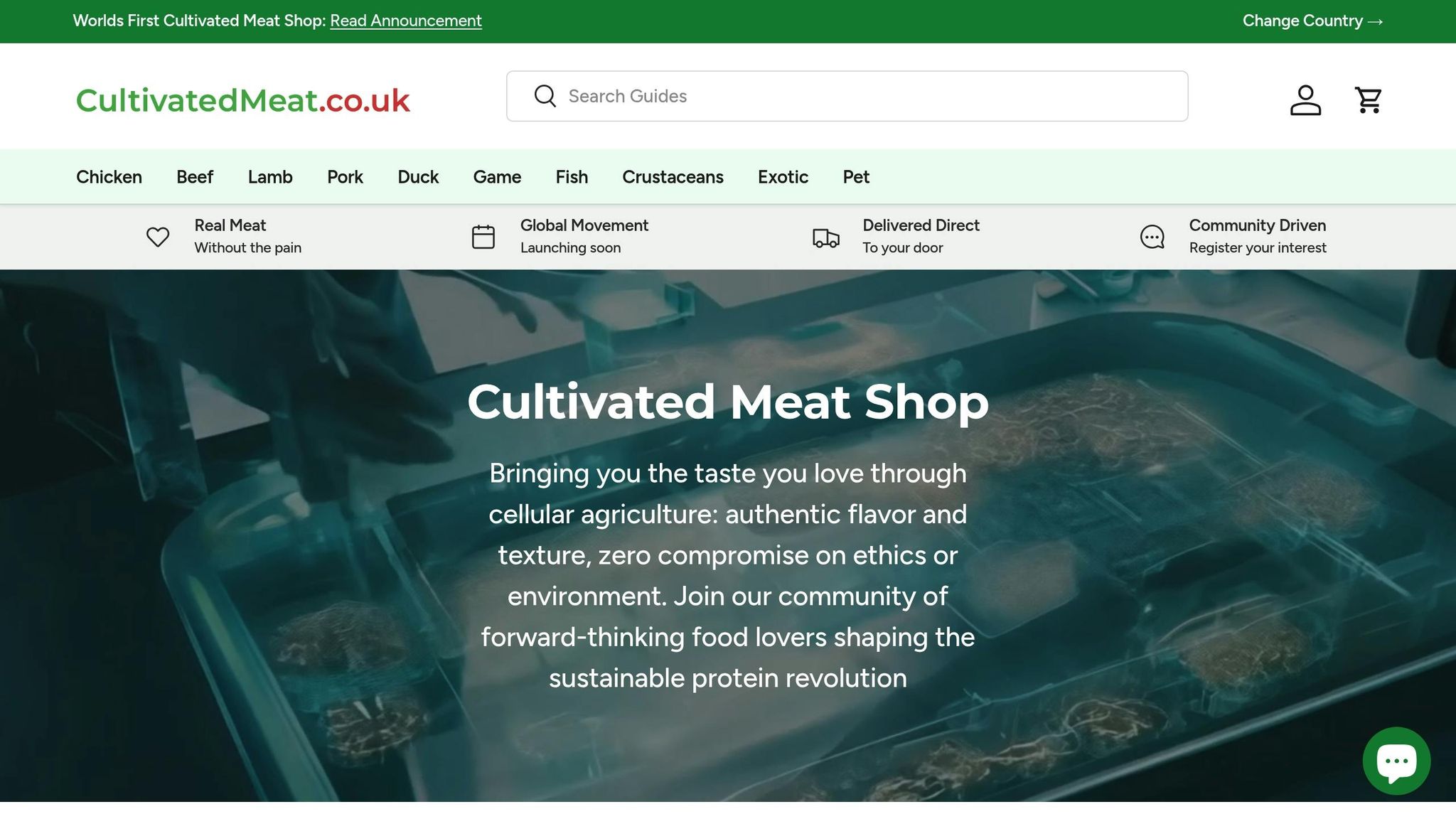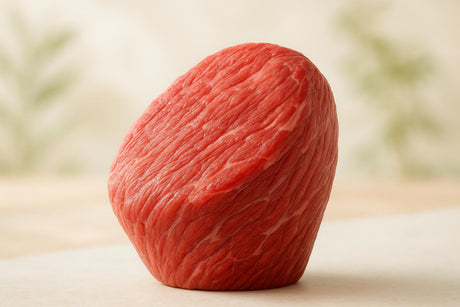Cultivated Wagyu is a new way to produce premium beef without farming cattle. Using advanced cell-growing techniques, it replicates the marbling, flavour, and texture of Wagyu beef while reducing resource use and emissions. Companies like Ivy Farm in the UK are leading efforts to make this meat more accessible and environmentally friendly. Here's what sets it apart:
- How It's Made: Stem cells from Wagyu cattle are grown in fermentation tanks and assembled using 3D bioprinting to mimic Wagyu's marbling.
- Taste & Nutrition: Producers can adjust fat and amino acid levels for consistent flavour and improved health benefits.
- Environmental Impact: Uses up to 96% less water, 99% less land, and emits up to 92% fewer greenhouse gases than conventional beef.
- Ethics: No animal slaughter is required, addressing welfare concerns linked to traditional farming.
- UK Availability: Regulatory approvals are underway, and cultivated Wagyu could hit UK markets by 2025–2026.
This method offers a consistent, high-quality alternative to conventional beef, addressing both consumer demand and sustainability challenges.
How is Cultivated Wagyu Made?
Cultivated Wagyu is at the forefront of cellular agriculture, blending cutting-edge biotechnology with the rich culinary tradition of Japan. This innovative process begins with the extraction of stem cells from premium Wagyu cattle, which are then cultivated to replicate the iconic marbling and flavour that Wagyu beef is celebrated for.
The Production Process
The journey to creating cultivated Wagyu starts by isolating two types of stem cells: bovine satellite cells and adipose-derived stem cells. These cells are the building blocks of Wagyu, capable of developing into muscle, fat, and blood vessel tissues – the key elements that give Wagyu its signature texture and taste [2].
The real breakthrough comes with the use of 3D bioprinting technology, which allows researchers to construct these tissues with remarkable precision. Scientists at Osaka University have developed a method that uses the natural structure of Wagyu beef as a guide.
"Using the histological structure of Wagyu beef as a blueprint, we have developed a 3D-printing method that can produce tailor-made complex structures, like muscle fibers, fat, and blood vessels" – Dong-Hee Kang, Lead Author [1][2]
This process takes inspiration from traditional Japanese confectionery techniques, particularly the crafting of Kintaro-ame candy, where intricate patterns are formed through careful layering. Similarly, the cultivated Wagyu fibres are arranged in 3D to recreate the distinctive marbling pattern [2][3].
To support the development of these tissues, researchers use artificial tendon tissue made from type I collagen. This provides the structural support needed for stable muscle growth during the cultivation process [3].
The production itself happens within bioreactors - large fermentation tanks designed to maintain the ideal environment for cell growth. These systems carefully regulate temperature, pH, and nutrient levels to ensure consistent quality throughout the process [4]. This meticulous assembly lays the foundation for achieving Wagyu's signature taste and texture.
Controlling Flavour and Texture
Once the meat's structure is complete, the focus shifts to perfecting its flavour and nutritional profile. One of the standout features of cultivated Wagyu is the ability to precisely control its taste and composition. By modifying the growth media, such as adding oleic acid to encourage fat development, producers can fine-tune the meat's tenderness and nutritional value [7].
"By improving this technology, it will be possible to not only reproduce complex meat structures, such as the beautiful sashi of Wagyu beef, but to also make subtle adjustments to the fat and muscle components" – Michiya Matsusaki, Senior Author [6]
This level of control extends to adjusting the fatty acid profile, allowing for reductions in saturated fat while preserving the rich, buttery flavour that defines Wagyu [7]. Considering that traditional Japanese Wagyu contains over 50% fat, this represents a major advance in meat production [7].
Companies like Mosa Meat are already showcasing the commercial potential of this approach, having developed plant-based growth media that cut production costs by up to 80% [5]. Similarly, Aleph Farms has introduced scalable bioreactor systems to optimise cell density, further improving efficiency [5].
"Cultured fat cells (adipocytes) are therefore a possible answer to the problem of improving the organoleptic properties of alternative meats in a customizable and scalable manner." [7]
This precise control over the production process means cultivated Wagyu can deliver consistent quality unmatched by traditional farming, where variables like feed, genetics, and environmental factors often lead to variation. The result is Wagyu beef that not only lives up to its legendary reputation but also offers improved nutritional benefits and a smaller ecological footprint.
Cultivated Wagyu vs Traditional Wagyu
Cultivated Wagyu has the potential to rival - and even surpass - the umami depth of traditional Wagyu, thanks to higher levels of free amino acids. Studies show that Cultivated Meat can contain up to twice the amount of free amino acids found in conventional beef. Among these, glutamic acid is the most prevalent, followed by aspartic acid [8].
This enhanced amino acid profile allows for precise flavour customisation during production. Shoji Takeuchi, a senior author of the study, highlights this advantage:
"This discovery is promising because it provides a means to adjust the flavor of cultured meat by manipulating the amino acid levels in the medium" [8].
By tweaking the growth medium, producers can fine-tune the flavour profile, creating a tailored culinary experience. Beyond taste, this controlled process also impacts the meat's nutritional value and cooking characteristics.
Nutritional and Cooking Properties
Cultivated Wagyu production offers another advantage: the ability to refine flavour through ageing. This process further enhances the amino acids, ensuring a consistent and rich umami taste [8]. In fact, it could result in a more pronounced flavour compared to the natural variability of traditional Wagyu.
The controlled environment of cultivated production eliminates the unpredictability of traditional farming, where factors like feed, genetics, and environmental conditions can lead to fluctuations in quality. This precision ensures a more consistent product, both nutritionally and in cooking performance.
Environmental and Ethical Benefits
Cultivated Wagyu brings a host of environmental and ethical advantages, making it a responsible alternative to traditional beef production. These benefits align seamlessly with its innovative production process, positioning it as both a premium and conscientious choice.
Environmental Impact
Research from Oxford University highlights the stark contrast in resource use between cultivated meat and conventional methods.
"What our study found was that the environmental impacts of cultured meat could be substantially lower than those of meat produced in the conventional way. Cultured meat could potentially be produced with up to 96% lower greenhouse gas emissions, 45% less energy, 99% lower land use, and 96% lower water use than conventional meat." - Hanna Tuomisto, Oxford University's Wildlife Conservation Research Unit [10]
Traditional meat production consumes up to 19 times more land than cultivated beef [11]. In the case of cultivated Wagyu, this means freeing up vast tracts of land currently used for grazing and growing feed crops. Such land could be repurposed for reforestation or carbon sequestration efforts [10].
Additionally, cultivated Wagyu requires up to 96% less water and occupies only a fraction of the land used in traditional beef farming [9][10]. Studies indicate that cultivated meat could reduce global warming impacts by up to 92% and air pollution by 93% compared to conventional beef production [11].
Yaakov Nahmias from Future Meat Technologies underscores the broader vision:
"Our goal is to make cultured meat affordable for everyone, while ensuring we produce delicious food that is both healthy and sustainable, helping to secure the future of coming generations" [9]
Looking ahead, Elliot Swartz, a Senior Scientist at the Good Food Institute, predicts:
"As soon as 2030, we expect to see real progress on costs for cultivated meat and massive reductions in emissions and land use brought about by the transition to this method of meat production." [11]
With its resource-saving potential, cultivated Wagyu not only lightens the environmental load but also sets new ethical standards in meat production.
Animal Welfare Considerations
One of the standout features of cultivated Wagyu is its ability to address ethical concerns around meat consumption by completely removing the need for animal slaughter. This shift appeals to consumers who enjoy Wagyu’s taste and texture but are uncomfortable with traditional farming practices.
Conventional Wagyu farming often prioritises fat marbling over animal welfare, sometimes at the expense of the animals' comfort and natural behaviours [12]. Furthermore, the slaughter process itself raises significant welfare issues. Studies reveal that up to one in eight cows may not be properly stunned before slaughter, resulting in unnecessary suffering [12]. Cultivated Wagyu eliminates this risk entirely by bypassing the need for slaughter.
"The bottom line is that buying wagyu beef is no guarantee of high animal welfare standards, nor does it even mean that you're getting beef from a wagyu cow." [12]
This statement highlights the gap between consumer expectations and the realities of traditional Wagyu production. With cultivated Wagyu, there’s complete transparency and assurance that no animals are harmed in the process.
Beyond individual animal welfare, cultivated Wagyu invites a broader rethinking of our relationship with animals and food production. It offers a way for consumers to indulge in a luxurious dining experience while aligning with values of compassion and environmental responsibility. For those who have wrestled with the ethical dilemmas of eating meat, cultivated Wagyu provides a guilt-free option that delivers on taste, texture, and culinary satisfaction.
sbb-itb-c323ed3
Cultivated Wagyu Availability in the UK
The UK is making strides in setting up a regulatory framework that could soon see cultivated Wagyu available to consumers. These developments highlight the growing potential of this new food category.
Market Access and Regulations
The Food Standards Agency (FSA) is working to establish a rigorous safety assessment process for cultivated meat products, including cultivated Wagyu. To support this effort, the FSA received £1.6 million in government funding to streamline and maintain high standards in the approval process for such products [13].
Currently, applications for cultivated meat products, such as steak and beef, are under review [13]. The agency aims to complete safety assessments for two cultivated meat products by 2027, marking a key step forward for the industry [15].
"Companies are obviously aiming for products indistinguishable from the animal equivalent, but the way they are achieving that is fundamentally different."
– Prof Robin May, Chief Scientific Adviser at the FSA [13]
In July 2024, Meatly, a UK-based cultivated meat company, received regulatory clearance for one of its products [14]. Similarly, Aleph Farms submitted an application for approval in August 2023, with the FSA’s review process expected to take around two years [14]. This timeline suggests that cultivated Wagyu could reach UK consumers as early as 2025–2026.
To further support the industry, the FSA launched a pilot programme in June 2025 designed to help cultivated meat companies navigate the authorisation process more effectively [15]. Thomas Vincent, Deputy Director of Sandbox and Innovation at the FSA, explained:
"The FSA's role is to make sure all foods are safe before they are sold in the UK... As cell-cultivated products are now being developed in new and innovative ways, it's vital they continue to meet our high safety standards. This new service will help businesses understand what is needed to prove their products are safe, and guide them through the authorisation process." [15]
As part of this initiative, eight companies, including UK-based firms like Hoxton Farms, Roslin Technologies, and Uncommon Bio, were selected for the FSA’s regulatory sandbox. This programme is supported by the £1.6 million Engineering Biology Sandbox Fund [15]. These measures are paving the way for premium products like cultivated Wagyu to enter the UK market.
Role of Cultivated Meat Shop

As regulations progress, educating consumers about cultivated meat becomes increasingly important. This is where Cultivated Meat Shop steps in, acting as a vital resource for those curious about this cutting-edge food technology. The platform offers detailed information about cultivated meat, including how cultivated Wagyu compares to traditional Wagyu in terms of taste, texture, nutritional value, and cooking properties.
Cultivated Meat Shop keeps its audience updated on the latest developments in cultivated Wagyu through features like waitlist sign-ups, product previews, and news about regulatory advancements and company milestones. Its content also addresses common questions around sustainability, safety standards, and cooking techniques, helping consumers make informed decisions.
FSA surveys reveal that 16% to 41% of the UK population is open to trying cultivated meat [16]. This reflects a growing curiosity about these products. Cultivated Meat Shop helps bridge the gap between the unfamiliar and the familiar, showing how cultivated Wagyu can deliver the luxury dining experience people expect while also offering environmental and ethical advantages. By providing accessible, science-backed insights, the platform demonstrates how cultivated Wagyu combines indulgence with a forward-thinking approach.
Conclusion: Why Choose Cultivated Wagyu?
Cultivated Wagyu is reshaping what it means to enjoy premium meat. By combining cutting-edge technology with ethical considerations, it delivers the luxurious marbling, rich flavour, and tender texture Wagyu is famous for - while offering a fresh approach to how we think about meat production.
The environmental impact of traditional beef farming is staggering. It accounts for 25% of global land use, land-use change, and forestry emissions [18]. Cultivated Wagyu, on the other hand, offers a much lighter footprint. With renewable energy, it could slash carbon emissions by up to 92% compared to conventional beef. Water usage could also drop by as much as 96% [19]. These numbers highlight how cultivated Wagyu could transform the way we approach sustainability in food.
But it’s not just about the planet - it’s about precision too. Producers can fine-tune cultivated Wagyu’s nutritional profile, boosting beneficial fats like monounsaturated fats and omega-3s in ways traditional farming can’t. For example, a 2020 study in the Journal of Animal Science found that Wagyu beef naturally contains high levels of oleic acid, a monounsaturated fat linked to both its distinct taste and potential health benefits [20].
Ethics also play a key role. Cultivated Wagyu eliminates the need for animal slaughter, offering an authentic alternative that plant-based substitutes simply can’t replicate. Since it’s biologically identical to traditionally farmed meat, it delivers the full Wagyu experience without the ethical dilemmas [19].
Joel Salatin of Polyface Farm puts it best:
"You, as a food buyer, have the distinct privilege of proactively participating in shaping the world your children will inherit." [17]
While cultivated Wagyu isn’t on the market just yet, companies like Cultivated Meat Shop are paving the way for UK consumers by offering educational resources and previews of what’s to come.
FAQs
What does cultivated Wagyu taste like compared to traditional Wagyu?
Cultivated Wagyu is crafted to mirror the rich, indulgent taste that has made traditional Wagyu beef a global favourite. Renowned for its buttery texture, intricate marbling, and deep umami notes, traditional Wagyu is a culinary treasure, and cultivated Wagyu strives to recreate that same luxurious experience.
Offering a tender, melt-in-the-mouth sensation and a complex flavour profile, cultivated Wagyu provides an appealing alternative to its conventional counterpart. Best of all, it delivers this premium taste without requiring animal slaughter, making it a forward-thinking way to savour the qualities that make Wagyu so exceptional.
What are the health benefits of cultivated Wagyu compared to traditional beef?
Cultivated Wagyu beef may offer some health perks compared to regular beef. For starters, it typically contains less saturated fat and more monounsaturated fats, such as oleic acid. These fats are known to promote heart health by helping to lower LDL (bad) cholesterol while boosting HDL (good) cholesterol.
Another benefit is the ability to adjust its nutritional profile. This means it can be designed to include more beneficial nutrients while reducing harmful elements. Such flexibility could make it a safer and healthier option for those looking for an alternative to traditional beef.
When will cultivated Wagyu be available in the UK?
Cultivated Wagyu is anticipated to hit the UK market by 2025. Companies are currently focused on expanding production capabilities and navigating the regulatory approval process - an essential hurdle before it can be sold commercially.
Though the exact timeline will depend on how swiftly approvals are granted, cultivated Wagyu promises to deliver the same rich flavour and melt-in-your-mouth tenderness as traditional beef. It’s poised to offer a forward-thinking, eco-conscious alternative for beef enthusiasts in the not-so-distant future.













